#also don’t know if classical pianist makes sense because I played piano for 8 years but I don’t know English terminology :(
Text
No but like….
Lestappen musician au where they’re neighbors and Charles is a classical pianist and Max is a drummer in a band and Charles drives him crazy playing piano all night long so in return he drives Charles crazy playing drums all day long
So Max is basically falling asleep at practices because he can’t sleep at night because of Charles’ playing and Charles is also falling asleep at practices because he can’t sleep at all during the day because of Max’s playing and neither of them are thinking of logical solutions because obviously the solution is to make it worse and worse every single day until one of them gives in but neither of them want to be the first to confront the other
Do you see the vision?????
#I want to read a fic idk man#drummer max does things to me it’s involuntary and too powerful in general#and yes#lando and Daniel are also in the band#also#something about Max not being able not sleep because of the piano and then sort of growing fond of it even after fighting with Charles-#-teeth and claw AND THEN MISSING IT AND NOT BEING ABLE TO SLEEP WHEN HE ISNT PLAYING#alright I need sleep I need therapy#also don’t know if classical pianist makes sense because I played piano for 8 years but I don’t know English terminology :(#max verstappen#charles leclerc#Lestappen#formula 1#delete later#maybe
124 notes
·
View notes
Note
I LOVE YOUR PORN AU!!!!! LIKE SO MUCH - and i'm just. if you don't mind me asking, how - the way you flesh out the characters, their motivations, and feelings in every scene in such an eloquent way, and just little things here and there, a habit or an activity that adds dimension to who they are, and - your prose is wonderful. you achieve this addictive, engrossing narrative space that readers just absolutely melt into, and i have to ask - how did you develop your writing style? 1/2
what books did you read that formatively shaped the way you write? or you know, what did you do to improve your writing? i'm so in awe of how you world-built and established the porn au - like lqg & hc being national taolu champions?? how do you come up with that stuff? i cannot comprehend the amount of research and effort that must've gone into porn au, and i'm just so deeply thankful that you decided to share that with us. i apologize if i'm coming on too strong, but wow. thank you 2/2
--
oh my god please don't apologize, when i saw your ask i rolled on the floor giggling hysterically for a solid 15 min, bless your heart
part of the answer to your question—i've taken like, 8 years' worth of creative writing classes/workshops! there was also a transnational literary component to my degree so whenever possible, i took literature classes fksjdfksd so whatever you see and like is definitely the result of a lot of work. My writing from not even 10 years ago but like, 5? horrid, ridiculous, wild, cringe. The Porn AU itself is the second draft of a MUCH more lackluster piece.
about my writing style. gosh, you really know how to make a writer blush. "I like your writing style" is literally an instant kill LMFAO okay okay, the useful answer: my primary criteria for choosing what to write is, don't be obvious, be interesting. Fiction tells us to show, not tell, right? Poetry is about concretizing the abstract. Screenwriting says cut all useless lines. A lot of writing rules and advice—never start with the weather, avoid detailed descriptions of the characters, don't use adverbs, etc.—are all really about this exact sentiment.
I once took a seminar on writing for horror movies. The golden rule of the horror genre is Never Show the Monster, because whatever the audience is imagining is always going to be scarier than what you actually show them. There are obviously exceptions to this (to all writing rules), but in my mind, it's all the same principle.
LONG answer under the cut
So you start with building a scene. I approach it like essay-writing—I state my thesis for the motivations/main propulsion of the plot. "In this scene, LQG and SY are motivated to save Cang Qiong's porn production, so they have sex on camera." Then you build the sub-motivations: "LQG is also doing this because he's pining after SY."
I learned this "thesis-writing" from theater, specifically from writing 10-min plays. Theater is all about characters being driven by their wants and needs, and the reason I say 10-min plays in particular is because longer forms of writing will give you more leeway, but in 10-min, you pretty much need your character motivations established from their very first line. That's why you need that very clear thesis for yourself—if you don't even know what the character wants from the get-go, then you can't establish who they are, what they want, and where they're going to go in a dynamic and interesting way.
So this thesis drives EVERYTHING that happens in your scene, just like an actual thesis for an essay, just like topic sentences for your paragraphs. Once I do this, I have the emotional direction & narrative scope of how much this scene will cover, I have a sense of where it begins and ends. "Begin with the dynamics of their sex. LQG starts showing signs of his feelings. Reveal LQG backstory for exactly what those feelings are and why he isn't telling SY. The rest of the scene implies that LQG's feelings may not be so unrequited, but also sets up the fundamental problem at the heart of the whole fic—SY's inability to comprehend his own feelings." This is kind of my new thesis now. They're having sex; LQG pines; SY doesn't know he himself is pining.
Now it's time to manifest. This is the "storytelling" part, and the hardest lmfao.
Personally, my approach is largely shaped by my very cool screenwriting teacher, who hammered into us: don't fucking waste lines. The Golden Rule of screenwriting is that every line should reveal something new. I found my old writing kind of repetitive, especially on the emotional front, so this is kind of my editing mantra now—is this line either propelling the story or revealing character? If it's revealing character, is it a revelation that has to happen right now, or is it slowing the momentum of the scene?
But these aren't rhetorical questions! "Momentum" doesn't just mean tumble forward as fast as you can, it also means taking the time to draw the bowstring back further, so your next move has even more propulsion. That's why you get the little "LQG has been in love with SY..." cut scene in the middle of the fucking (at least, that's my reasoning for putting it there). Every line has to bring a fresh revelation that "proves" your thesis further.
That brings me to the details. You said you like the details I inject into the world-building, and honestly that's so gratifying to hear, because that means I'm successfully manifesting my intentions, y'know? "Every line has to bring new info" kind of sounds like a tall order, but the most effective way I've seen it done in books and onstage/onscreen is with these hyper-specific details. If you're writing a scene in which someone feels dirty, never have them just say that—have them say they want to take a shower. Show them running out of bleach again as they scrub down the stall after they wash. Begin the scene like "Steve always washes his throat first now." Then pack the scene with even more revelatory details: "Soap in hand, he heard the pipes above his head groan for a half note on adagio, and readied himself for the blast of icy water that always followed." Shitty shower, probably not rich, is likely a classical musician.
By the same token, I want to build LQG's character. The "Liu Qingge has been in love with Shen Yuan" section is the first insight we get into his background and perspective, right, so: I need to establish LQG's emotional context for filming this scene -> I can characterize him as a nut for martial arts in the same stroke -> so this takes place at a gym, beating up sandbags is a classic way of showing manly emotional distress -> so give me more details on this gym -> Puqi Gym, XL the martial god is obviously the owner -> how do I have XL & LQG a relationship beyond gym owner & client? They spar together -> I want XL & HC's position in this AU to mirror their god/ghost king statuses in TGCF canon -> how can I concretize their fighting prowesses in real-world details? -> they're martial arts champions -> what's an actual competitive martial art form that involves weaponry? -> wushu -> wikipedia Wushu, find taolu weapons sparring
(I just realized that in my songxiao daycare AU, Hualian are Olympic gold medalists by the same narrative logic laksjdnflaksjdnflsd)
So, that's the flow of logic behind my world-building lmao. It's all in the details. Leverage is one of my all-time favorite TV shows and the way they build their stories is super inspiring. If their thesis is "the rich and powerful take what they want, we steal it back for you," they manifest it in the most specific and concrete narratives: mine workers who like the work but are fighting for workplace safety vs. the money-grubbing mine owner who will blow up their livelihoods if it means a bigger payday; the little girl from Iraq with refugee status forced to be an accomplice to antique smuggling vs. international smuggler with a fetish for British royalty.
Last pieces of writing advice I've gotten: pay attention to the real world. A writing exercise we did was just sit in a public spot and make concrete observations on our surroundings. There are stories in everything!!! I learned to observe things like weird holes in the concrete (earthquake? drilling accident? bullet mark?), odd patches of moss or bird shit (look overheard: it's an AC unit dripping water for the former and nesting swallows for the latter), ladies in flipflops walking alongside ladies in high heels (excited mother walking her antsy daughter to the bus for the daughter's first job interview—the daughter's shirt collar is unfashionable and she's taking the bus, so there's a good chance the shoes were passed down, maybe from an office lady aunt. Maybe she's even overdressed for the interview, so will her outfit be an unintended source of tension once she gets to the interview? Is it a group interview, to make the comparison more stark?).
Also, write what you know. You know why SY is a video editor in porn AU? Because I'm a video editor. One of my more popular MDZS fics is set in a plant shop 'cause I worked in a plant shop. SL was First AD in Bachelor!AU 'cause I was First AD on a set once. Concrete details like the editing software having a split-screen, always answering questions about how often to water plants, and being up until 3AM editing call-sheets are the ones that will fully immerse your readers.
And if you can't do the actual things, just watch someone who is, listen to them talk, pick up lingo, and fake it. I watched like a 15-min vox video on fencing for the fencing!AU and a 45-min music theory video on the hospital pianist!AU (also I started learning piano sklfjnlsdjlfkjsd). Of course, I just finished reading a wangxian fic that had me going, "holy fucking shit, the author is literally getting their masters in a music program" so my 45-min youtube video ain't shit, but if you just need a little bit of character establishment, then it's enough to do the trick.
Anyways, tl;dr. Find the details, find the tension. Never tell outright what the tension is supposed to be, manifest it instead. Make the manifestation as interesting as possible, and if it's meant to be funny, make it funnier.
Sorry this turned into a fucking lecture lskjnflskdjnflskd but last thing, someone asked me before if I had formative authors, and this was the list I wrote at the time:
Angels in America (play) by Tony Kushner
The God of Small Things (novel) by Arundhati Roy
The Penelopiad (novel) by Margaret Atwood
“Litany in Which Certain Things are Crossed Out” (poem) by Richard Siken
Night Sky with Exit Wounds (poetry) by Ocean Vuong
Giovanni’s Room (novel) by James Baldwin (and then Go Tell it on the Mountain and then his essays)
Franny and Zooey by J.D. Salinger
And, ooh, now that I have this list I think I can even roughly sort it as such: Kushner, Atwood, Siken, and Salinger I really latched onto for their dialogue and very present narrator voice—same is true for Go Tell it on the Mountain. Roy, Vuong, and Giovanni’s Room, I think, are texts more representative of the kind of saturated figurative language I like, and emulate. Of course they all do imagery and voice and overall structure amazingly, but that’s the rough dividing line I’d draw.
But yeah James Baldwin is my fucking hero.
#long post#about me#writing#jesus sorry i spent way too long on this laksjdnflaskjdnflaskjndflas#but anyways i'm super grateful you gave me the chance to introspect and articulate all this#i'm exceedingly grateful too to all the writing mentors i've gotten to have#personal#these are the principles and rules i've learned and#i still definitely screw the pooch#on them#so you know this is just what's on my mind#this is how i school myself
11 notes
·
View notes
Text
Jazz Potluck - Episode 01.

Like countless folks around the world, I LOVE music. Pretty much any and all genres. JAZZ however, is the music that seems to bring the most joy in my life. As a creative person, I always need to have music on in the background while I work, (well, all the time really) and jazz has always seemed to catalyze my creativity.
I dig this sentiment from the late writer Anaïs Nin:
>>>"Jazz is the music of the body. The breath comes through brass. It is the body’s breath, and the strings’ wails and moans are echoes of the body’s music. It is the body’s vibrations which ripple from the fingers. And the mystery of the withheld theme, known to jazz musicians alone, is like the mystery of our secret life. We give to others only peripheral improvisations."
This “Jazz Potluck” is something that I’ve been wanting to do for years and years, but I never quite got around to it... (I’ve got enough plates spinning already, not much room for another! Hehe.) Anyway, I’ll be sharing Spotify playlists here as often as I can... containing a rich mix of jazz that I love, and would love for YOU to love! I’m certainly no music critic, and I’ve no intention of “analyzing” the music I share, the way that a professional might. But, I will provide some brief personal notes about the songs in the playlists, and hopefully some jumping off points for further exploration, if you dig what you hear!
So without further ado, here’s the very first edition of my Jazz Potluck... Episode 01! There are 16 songs here, with no particular theme, other than that I DIG ‘em, and they get a lot of rotation in my headphones! Quite an eclectic mix!
Here’s the direct link to the playlist on Spotify - Jazz Potluck, Ep 01.
A preview of the tracks in the playlist, and some brief notes on the songs, below.
“Dirty Blonde” by The Bad Plus
“Giant Steps” by John Coltrane
“Chinoiserie” by Medeski, Martin and Wood
“This I Dig of You” by Hank Mobley
“The Windup” by Julian Lage
“3-in-1 Without The Oil” by Roland Kirk
“Gangsterism on the Rise” by Jason Moran
“II B.S.” by Charles Mingus
“It Might As Well Be Spring” by Brad Mehldau
“Gazzelloni” by Eric Dolphy
“Nu Nu” by Avishai Cohen
“Salmon Jump Suite” by Happy Apple
“Brother Mister” by Christian McBride & Inside Straight
“Tiffakonkae” by Kamasi Washington
“Greasy Granny” by the Charlie Hunter Trio
“Cease the Bombing” by Grant Green
Playlist - EP 01.
01. “Dirty Blonde” by the trio “The Bad Plus.” Starting this thing off with a BANG! From the moment I first heard this song back in 2004, I knew that I had stumbled on a Jazz Trio with something utterly unique in their music. A piano, bass and drum trio that has produced some delightful original material over the years, as well as a bunch of “cover” songs that in some ways, helped make them famous in the Jazz world.
For all of the critical acclaim the band has received over the years, one thing that has always stood out to me is the HUMOR in their music. They are often filed under “Avant Garde” Jazz... but they are really in a sub genre of their own. They play with real heart and soul, but they don’t take themselves too seriously, and they KNOW how to have a good time. When you hear all hell break loose at the 2:44 mark in “Dirty Blonde,” you’ll know that you came to the right party.


02. “Giant Steps” by John Coltrane. What can I say... I listen to this song pretty much EVERY MORNING when I wake up. If not immediately after I open my eyes, certainly by the time I’m making coffee. The fast paced tempo and saxophone wizardry of Coltrane and his crew in this Jazz standard always motivates me to get going.
If you’re not familiar with the song, here is a FANTASTIC video backgrounder on the piece, called “The Most Feared Song In Jazz, Explained.” I highly recommend watching it right before or after listening to the song. VERY enlightening!


03. “Chinoiserie” by the trio “Medeski, Martin and Wood.” What an amazingly funky cover of the Duke Ellington composition! I’ve been a fan of MMW since the early 90′s, and this album is probably my favorite, next to “Shack Man.” Medeski rocking the Hammond B3 Organ, Chris Wood’s bouncing bass, and Billy Martin’s frenetic drumming, make this tune just boogie right along. Be sure and listen to Duke’s original version of the song, to see how it sounds with a much larger band!
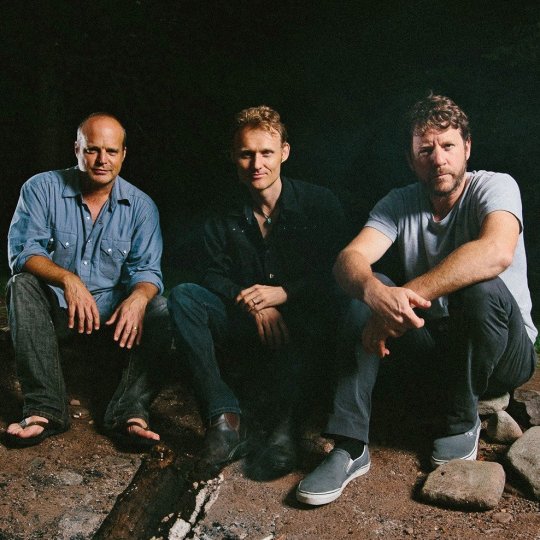

04. “This I Dig of You” by Hank Mobley. Uptempo, feel-good tune! (And I love Art Blakey’s drum solo around the 4:50 mark!) This is widely considered to be Mobley’s most popular original composition.
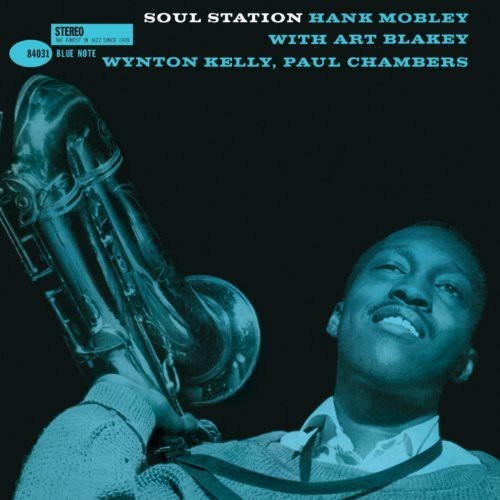

05. “The Windup” by Guitarist and Composer Julian Lage. This tune features his current Trio. I was a latecomer to the music of Julian Lage. I only really started listening to his music in 2019... but I’ve made up for lost time! (I think I have his entire catalogue now!) If you’re not familiar with Lage, he’s a prodigy and was recognized as such by age 12. Now he’s in his early 30′s, and a career that’s going strong!


06. “3-in-1 Without The Oil” by Roland Kirk. If you’ve heard of Roland Kirk (who later went by Rahsaan Roland Kirk) you’re likely aware that he was famous for playing multiple instruments at once. I always found his crazy, loosy-goosey style to be sort of “optimistic” if that makes sense? Very unconventional, and devil may care!
And speaking of his talent for playing multiple horns at the same time, here’s a passage from my FAVORITE novel, “Another Roadside Attraction.” Author Tom Robbins seems to really peg Roland Kirk in just one sentence.
>>>They are playing phonograph records, some wild new jazz. Straining my ears just now I heard Amanda ask, “John Paul, is it true that Roland Kirk is the entire Count Basie orchestra in drag?"
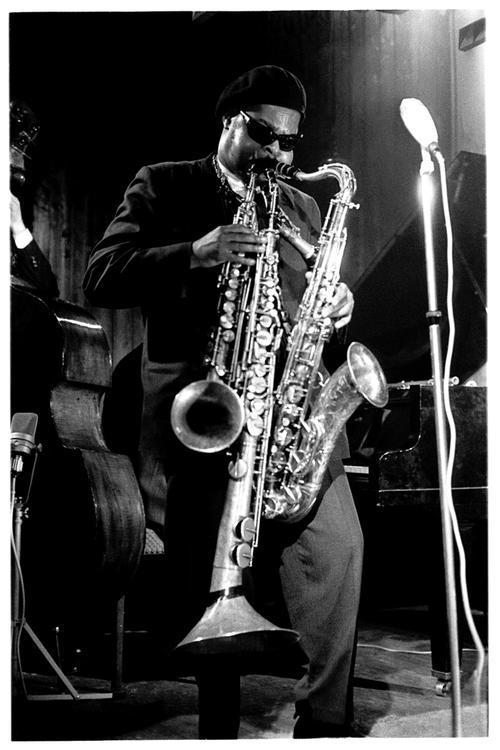

07. “Gangsterism on the Rise” by Jason Moran. I love the heavy left hand Moran utilizes on his piano in this tune. (Not unlike Pianist Ethan Inverson from “The Bad Plus” in “Dirty Blonde,” the first track in this playlist.) Boom boom boom! Here’s a quote from a music critic that pegs Moran’s style quite well: >>>“Moran is a spellbinding virtuoso who moves between boogie, avant-funk and Brahms as if he had never heard a good reason not to.”
He’s also a stylish sort of fellow....


08. “II B.S.” by Charles Mingus. I’ll have MUCH more to say about Mingus in future playlists... but I had to include at least one of his compositions in this 1st Episode! He is likely my all time favorite Jazz Composer. (He was an amazing bassist as well, but his compositions are what really knock my socks off.)
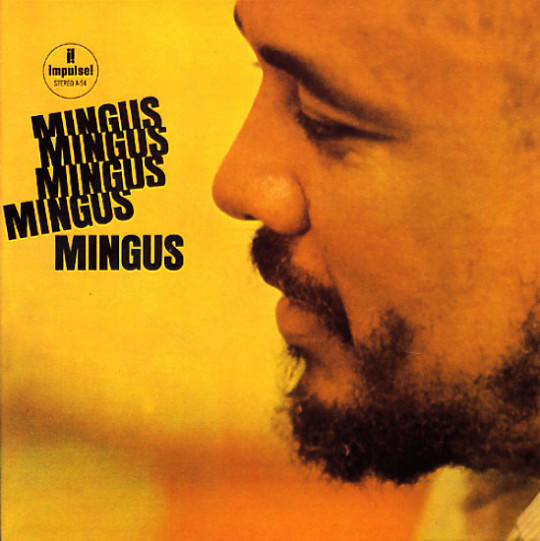

09. “It Might As Well Be Spring” by Brad Mehldau. This album was Mehldau’s major label debut, and was the first album of his that I purchased way back in 1995! What an AMAZING debut! I chose to include this cover of "It Might As Well Be Spring” because of it’s unusual and playful time signature. It’s a classic Rodgers and Hammerstein tune from the 1945 musical film “State Fair.” Mehldau does something really surprising with this classic tune, and it was such a breath of fresh air to me when I first heard it!
Here’s a passage I dig, from the great jazz book “Playing Changes,” by veteran Jazz Writer Nate Chinen. He zeroes in on what makes Mehldau’s rendition of the song unique.
>>>Introducing Brad Mehldau opens with a quick spray of staccato: tap-tap-tap, tap-tap-tap, like someone knocking impatiently at a door. It’s the preface to Mehldau’s arrangement of a show tune, “It Might As Well Be Spring,” from the Rodgers and Hammerstein film musical State Fair. The song had long been a verifiable jazz standard, with dozens of canonical recordings: by singers like Sarah Vaughan, Frank Sinatra, Ella Fitzgerald, and Nina Simone, and by others ranging from the pianist Bill Evans to the trumpeter Clifford Brown.
>>>Mehldau’s version arrived in 1995, precisely half a century after the line “I am starry eyed and vaguely discontented” made its way into the popular lexicon. He and his trio had made a neat structural modification to the tune, tinkering with its pulse in a way that their syncopated prelude set in clear relief. Instead of the even 4/4 cadence known as common time, the track races along in 7/8, creating the impression of a rhythmic hiccup, or a sprint with a hitch in its stride.
>>>Jazz musicians have been dabbling in irregular meters since well before Dave Brubeck’s enormously popular 1959 album Time Out, which made them an exotic selling point. What’s striking about Mehldau’s performance is where he ventures after the opening vamp, phrasing the melody in a cool, flowing cadence even as his partners, the bassist Larry Grenadier and the drummer Jorge Rossy, busy themselves with percolating chatter behind him. In his articulation of the theme, and in a solo full of deft intricacies punctuated with breathlike pauses, Mehldau gives the song a sleek, appealing contour. His performance doesn’t feel herky-jerky or cerebral. It feels natural, even inevitable.


10. “Gazzelloni” by Eric Dolphy. "Out To Lunch” was the first album I ever bought in the “Avant-Garde Jazz” genre. I certainly wouldn't have been ready for this album in my teens or early 20′s, but I’m really happy that I developed a taste for the genre in later years. It’s some of the most expressive Jazz that I’ve ever heard, and I LOVE to have it on when I’m designing something, or working on a painting. Seems to connect the creative synapses in my brain somehow!
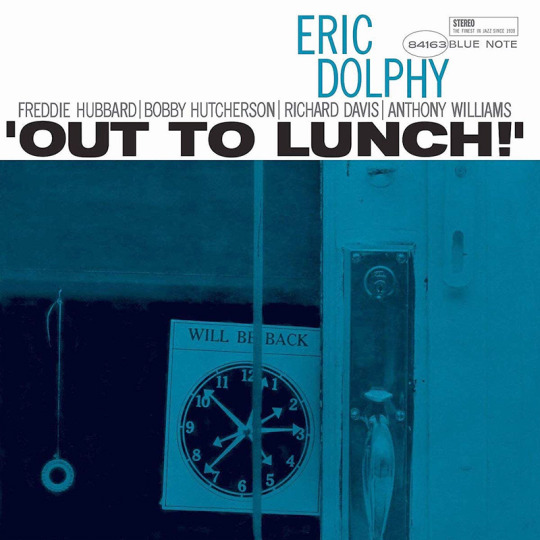

11. “Nu Nu” by Israeli Bassist and Composer Avishai Cohen. (Not to be confused with the Jazz Trumpeter of the same name.) This song is the opening track to Cohen’s album “Continuo” and really sets the tone for the rest of the album. I don’t know what time signatures Cohen uses in this tune, but they change up frequently over the course of 5 minutes. He’s a great composer, and a MONSTER on the bass. It’s said that he took up the bass in his early teens, because he was inspired by the legendary bassist Jaco Pastorius. (An inspiration that likely applies to MANY Jazz bassists since the 70′s.)
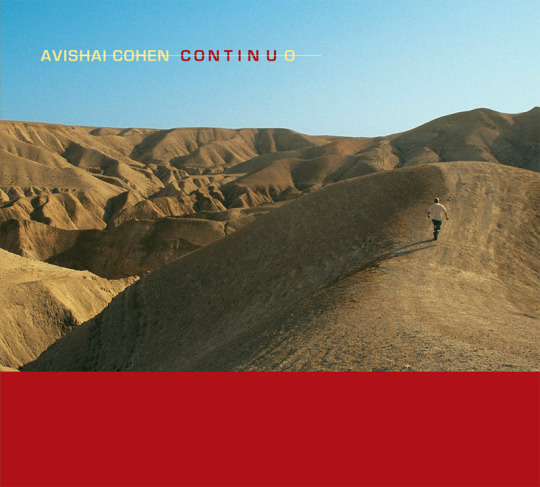

12. “Salmon Jump Suite” by the trio known as “Happy Apple.” This song is a smash-em crash-em DEMOLITION DERBY.... and I mean that in the most respectful and delightful way! Play it loud, and I think you’ll agree. Badass.
Oh, and the Drummer is Dave King, who’s main gig is as the Drummer for the aforementioned trio “The Bad Plus.” King is one of my favorite drummers, not just in Jazz, but it ALL genres of music. A real monster on the drums!
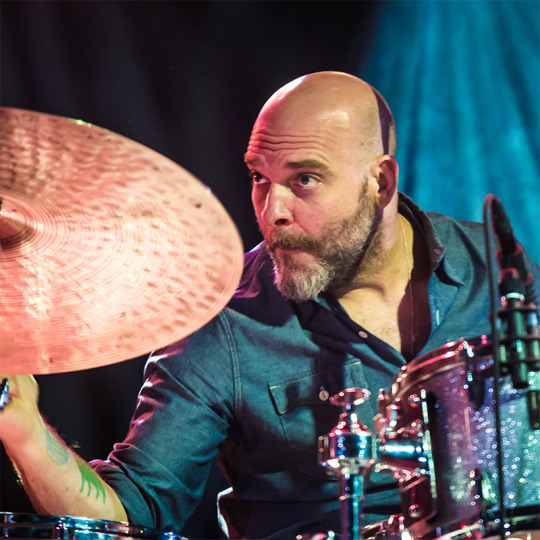

13. “Brother Mister” by Christian McBride and his band “Inside Straight” from the album “Kind of Brown.” McBride REALLY gets around as a bassist and composer... just scroll through his credits as a sideman on his Wikipedia page! One of the hardest working musicians in ALL of Jazz! His humor and playfulness comes across in both his playing, and his compositions, and "Brother Mister” is a great example of these. “Kind of Brown” is easily my favorite McBride album!
I should also note that McBride’s funny, extrovert personality has turned him into a popular Jazz radio host! You can catch him on Sirius X, NPR and other programs.
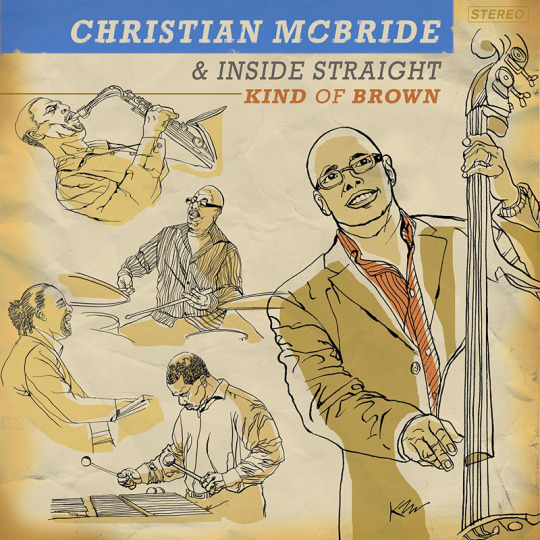

14. “Tiffakonkae” by Kamasi Washington. I simply cannot get enough of Kamasi’s music. I find him to be one of THE greatest talents to emerge in Jazz, in it’s entire history. I don’t think that is hyperbole. I was a couple of years late in discovering him, but since the day I heard his first album “The Epic,” he has been on my DAILY listening routine. No kidding.
If you like what you hear in this cut from his 2nd full length album, do yourself a favor and watch/listen to this special on NPR, that will show you some of what I’m talking about. It’s a 2 hour live performance and series of brief interviews with Kamasi and his collaborators, known as “The West Coast Get Down.” It might give you a buzz.
I’ll be featuring Kamasi and company on PLENTY of Jazz Potluck playlists going forward!!!
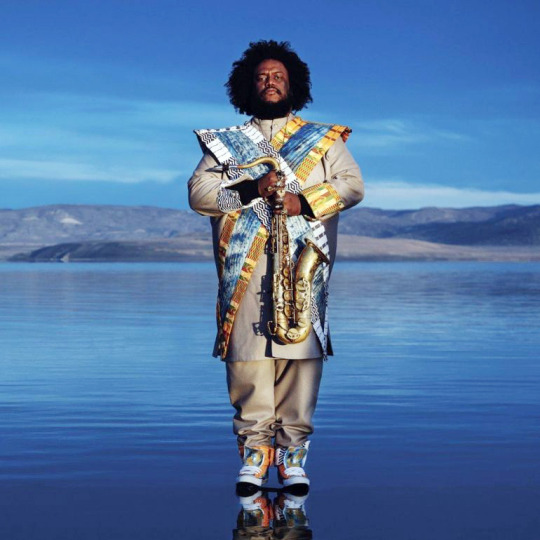
Here’s Nate Chinen again, from his book “Playing Changes,” talking about Kamasi bursting onto the scene. (Indeed, Chinen opens the first chapter of the book with Kamasi!)
>>>Kamasi Washington stood tall on a lot of big stages during his Year of Ascendance. Swaying in tempo, pushing heavy gusts through his tenor saxophone, he exuded the regal composure of a conquering hero: dauntless, doubtless, ablaze with rugged purpose. His sound on the horn—rangy and intemperate, or clipped and urgent—suggested an almost tactile force, a physical fact. He cut an equally imposing visual presence, in an unkempt Afro, a thick beard, and a dashiki, its patterned fabric loosely draped over his burly frame. And as his band raged around him, the music’s exultant sprawl enacted a ritual of transcendence. It was all rattling and ecstatic, maybe a little mystical. For many who bore witness, it was, brazenly, something to believe in.

15. “Greasy Granny” by the Charlie Hunter Trio. This album was my first introduction to this virtuosic Guitarist, back in 1995. (I seem to be including a number of albums from 1995 in this list... funny coincidence!) Anyway, as you listen to this tune, keep in mind that he is playing bass lines, chords AND melodies, ALL SIMULTANEOUSLY!!! I don’t know how in the hell he does it, but I’ve seen him performing live a few times over the years, and he makes it look effortless!
This song, “Greasy Granny” is as FUN as the name suggests.
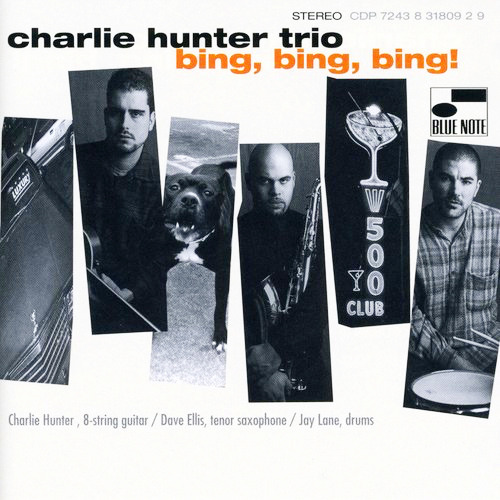

16. “Cease the Bombing” by Guitarist Grant Green, from his 1970 album “Carryin’ On.” Figured I’d close out this 1st Episode of the Jazz Potluck with a long and smooth groove. Easy like Sunday morning.........
Stay well, people!
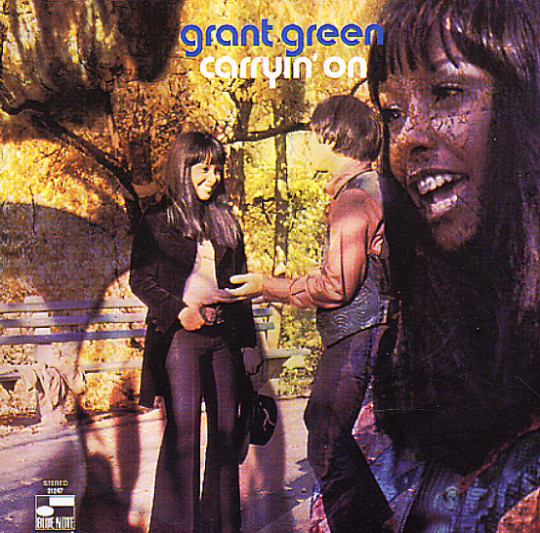
1 note
·
View note
Text
10 pieces under 10 minutes
If you follow my blog, you know that I love classical music and music history [and let’s face it, you probably do too]. But when people who want to get into the genre ask me for recommendations, I don’t know what to choose. The problem is the sheer AMOUNT of music out there...we’re talking hundreds of years worth of music to go through...so I decided to narrow down a list of ten pieces I’d recommend to anyone who’s new to classical and wants to explore more. Also, because time length was a major factor when I started out listening, I’ll keep the pieces relatively short, and I’ll try to pick music for different ensembles, from different time periods, and for different moods. This list is directed to complete newcomers to the genre, so if you’re into classical and want to read this, don’t get too concerned about the different titles and what they mean yet [i.e. you don’t need to know what makes a sonata a sonata in order to enjoy it], check out whichever of the pieces in the list stand out to you. If you like them and want more recommendations, you could always message me. My list of 10 pieces under 10 minutes:
1. Scriabin - Piano Sonata no. 4 [something dreamlike]
Scriabin was a Russian composer from the turn of the century who wrote very lyrical, melodic music. As time went on, his music became more and more unusual and experimental with harmonies, to the point that his late works aren’t written in any specific key. The fourth piano sonata is from his “middle” period, and is in two short movements. The first is a quiet, reflective, and the second is more energetic, ending in an ecstatic finale.
2. Bach - Prelude and Fugue in a minor BWV 543 [something spooky]
Thanks to silent movies, we associate the organ with Halloween, with castles and vampires and other gothic things. The Toccata and Fugue in d minor, attributed to Bach, is the most famous organ work in pop culture. Here is another organ piece that is similar, starting with a flowy prelude, and ending in a more complex movement called a fugue, where one melody is played over and over again in different keys while other lines of music play harmonic compliments.
3. Mendelssohn - The Hebrides Overture (Fingal’s Cave) [something adventurous]
This stand alone orchestral work starts off like a curtain unfolding, like the beginning of a movie, the music takes you on a journey, inspired by the Scottish highlands. This is the kind of music that would give you a rush, the type that could spark your imagination and make you think of cliffs along the ocean, large forests, the bright sun, or whatever else feels “right”
4. Part - Cantus in memoriam Benjamin Britten [something sad]
This is a work by a contemporary composer that was written after the death of another composer. The music is simple, the same descending melody played over and over again, but layered over each other, the work gets louder and recreates a sense of profound sadness. It moves me every time I listen to it.
5. Chopin - Nocturne op.27 no.2 [something soothing]
I say that tongue-in-cheek, but the music does make me think of a calming evening, eating at a restaurant with family, drinking wine maybe, but despite all that it isn’t forgettable background music. The piece has beautiful melodies, and it’s amazing to hear the pianist play two or three at the same time.
6. Ravel - Pavane pour une infante défunte [something nostalgic]
The music here is supposed to be a call back to old European court dances, and the title being “Pavane for a dead princess” doesn’t refer to anyone specific. You may recognize this music from the dance scene in The Dark Knight Rises. The longing melody is bittersweet, sad but still hopeful.
7. Schubert - Der Erlkönig [something dramatic]
This is a song about a man and his son riding on horses through the woods and being chased by the “Elf King”, a malicious creature that kills whoever he touches. The creepy story is enunciated by the rapid piano playing, and the drama by the singer who has to sing from the perspective of the narrator, father, son, and villain. All the drama of a large scale opera in under five minutes!
8. Vivaldi - Concerto for 4 violins in b minor [something elegant]
Maybe elegant isn’t the best word for this one, but usually when people hear Baroque music like Vivaldi’s concertos they think of powdered wigs and important aristocrats from the 16 and 1700s at dinner parties or balls. Don’t let that idea keep you from enjoying this music, which is very fresh, electric, and wild.
9. Liszt - Paganini Etude no. 6 [something wild]
Niccolo Paganini was a violinist who people say sold his soul to the devil for super human abilities. Franz Liszt was a pianist who fell in love with Paganini’s insane performances and worked to be just as impressive with the piano. This piece is a transcription [like a song cover] of one of Paganini’s and is a set of variations. You can see from the sheet music how difficult this piece is.
10. Copland - Fanfare for the Common Man [something grand]
This is a short piece for brass and drums, and in it we get a feeling of pride, achievement, hope, other sappy feelings. You’re probably heard this piece played at sports games. Overall it sounds like something motivational and fulfilling.
#classical music#classical#orchestra#piano#overture#etude#sonata#concerto#list#top 10#classical recommendation#classical introduction#what should I listen to#organ
112 notes
·
View notes
Text
Epic Movie (Re)Watch #106 - An American in Paris

Spoilers below.
Have I seen it before: No
Format: Blu-ray
1) The only person I know who shows up in this movie is Gene Kelly and that’s 100% because of his work in Singin’ in the Rain.
2) First line.
Jerry: “This is Paris and I’m an American who lives here.”
You know, I kinda figured that out from the title. But thanks.
3) Gene Kelly’s Jerry is pretty much the personification of so many art students.
Jerry [about people criticizing his work in English]: “They might be saying the same thing over here [in Paris] but it sounds better in French.”
4) If only more art students I knew were as honest as Adam.
Adam: “Im a concert pianist. That’s a pretty pretentious way of saying I’m unemployed.”
5) This whole relationship is a little bothersome to me.
Adam [about his friend’s lover]: “She’s a little young for you, isn’t she?”
Henri: “No! She’s only 19!”
The actor playing Henri was 36 and Gene Kelly - who played the other man in this woman’s life - was twice her age at 38. Not only that, but we learn the reason this girl (Lise) is with Henri is because during the war he took her in and looked after her while her parents were on the run. That sounds more like a father figure than anything else...and they have sex because of it.

(GIF originally posted by @centralperksource)
6) The use of ballet to introduce Lise and the contradicting parts of her personality (which, outside of the ballet, we don’t really get to see) is a unique device.
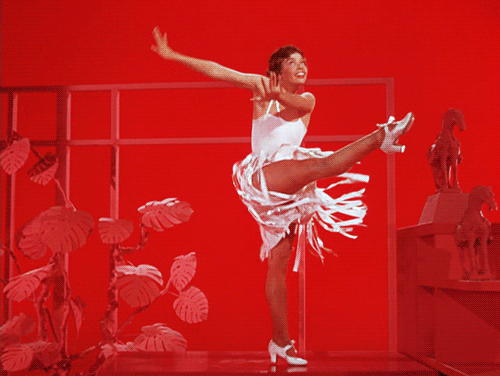
7)
Henri [about Lise]: “She’s the gayest girl in the world!”
Have you watched “Supergirl”? I beg to differ.
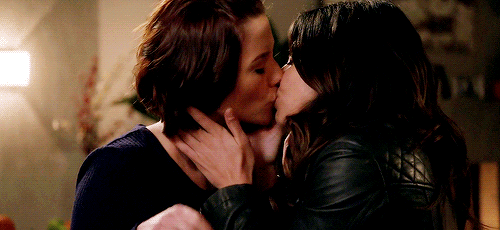
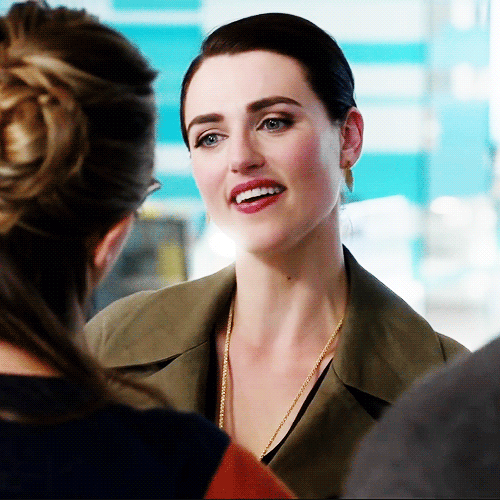
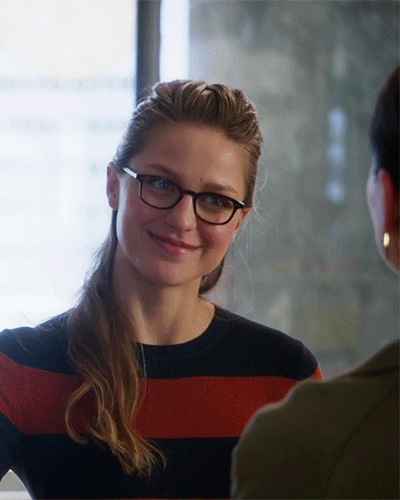
I’m sorry, I had to make that joke.
8) Jerry has this little monologue about how he’s depressed because he doesn’t have any money and what he does to get un-depressed involves the spending of money on things to cheer him up...which he can’t do because he doesn’t have money (which is why he’s depressed in the first place). Almost every art and college student alive can relate to that.
9) In most musicals characters are not aware that they are singing and dancing. In An American in Paris though, there are many onlookers enjoying the random song and dance numbers that take place near the cafe where Gene Kelly and company frequent. Which presents so many logic questions, the primary of which is this: how are they so good at randomly breaking into song and dance while having it be perfect?
10) Remember how I said Jerry is representative of so many art students?
Jerry [to a woman who was critiquing his art]: “If you say something nice it won’t make me feel better and if you don’t it’ll bother me.”
And then there’s this.
Jerry [when someone offers to pay him money]: “Gee, I don’t know.”
Milo [the woman offering the money for his work]: “You don’t know?”
Jerry: “I never thought it’d be an issue.”
11) There are a lot of great songs in this musical, but I have to say “I Got Rhythm” is probably my favorite. It just has a lot of fun and a nice positive energy.
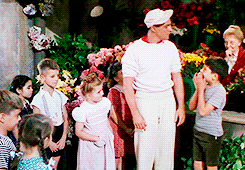
12) I love Milo. She is a layered female character who is as interesting (if not more so) than the male characters and even reprimands Jerry for his fragile masculinity at one point.
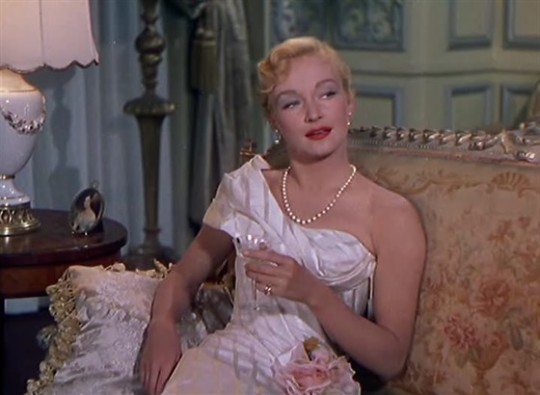
I wish we’d gotten more of her. I wish she and Jerry would have ended up together, but there wasn’t any passion in their relationship. Just mutual respect (which is nice).
13)
Jerry [to Milo]: “You should get married again. You need it...everyone does.”

14) Ah the “meet cute” which is actually “meet creepy” because Jerry is just staring at Lise - a girl he doesn’t know - from across the club and then forces her to dance with him.


(GIF originally posted by @ohrobbybaby)
Lise: “Now please, I would like to return to my table.”
Jerry: “In a minute.”
No. NOW. She told you what she wants. You’re making her uncomfortable. This isn’t cute, this is you forcing her into a situation she has said she doesn’t want to be in so let her go dude.
15) This random woman at Lise’s work, well...
Wendy: “I always get a rash if I have to decide anything.”

You should have that looked at. Either by a doctor or a psychologist, because making decisions for yourself is like the most basic thing human beings need to be able to do. Do you get a rash whenever you have to decide what you’re going to have for breakfast? What you’re going to wear? Do you make any decisions for yourself? Am I reading too much into a one off line? Should I move on?
16) This movie - like many movie musicals - features someone tap dancing on a piano while it’s being played. Wouldn’t that mess up the sound of the piano?

17) Most movie musicals use a song as a break from the story (the best exception being The Nightmare Before Christmas) and An American in Paris isn’t really any different. It’s like the movie hits pause for a little while to give us this song and dance. It’s entertaining, but is it necessary?
18) This line may not have been so true if I didn’t watch this movie at the end of 2016.
Jerry: “Civilization has a natural resistance against improving itself.”
19) This lyric may not have been so powerful if I didn’t watch this movie at the end of 2016.
Henri [singing]: “I’ll build a stairway to paradise with a new step everyday.”
That’s a good motto for 2017.
20) There is this extended scene inside concert pianist Adam’s head where he is having a concert. In this concert Adam serves as pianist, conductor, audience members, and even some other random musicians. It’s an interesting peak into who he is as a character, while also being the most development we get for him.

21)
Adam [after Jerry is relating woman problems]: “Women act like men and still want to be treated like women.”
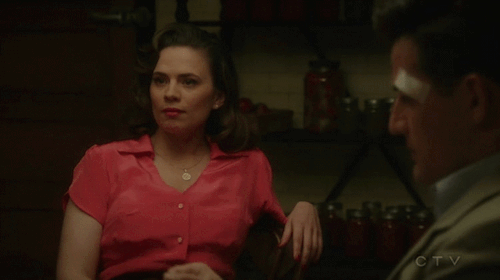
Or you know, people. They want to be treated like people.
22) When Adam realizes that Jerry is dating Henri’s girlfriend - something neither of them know - his reaction is absolutely hilarious. ESPECIALLY when Henri sits down and begins talking about Jerry’s love life without realizing who Jerry’s dating. Even giving romantic advice! And Adam is just freaking out, trying to smoke a cigarette, dropping it in his coffee, drinking his coffee, smoking the cigarette, etc. He even tries to change the subject!
Adam: “Did I ever tell you about the time I gave a command performance for Hitler?”
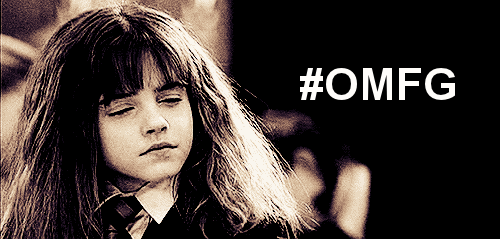
Watching Adam in this scene is what makes it and I love that.
23) Oh, and then Jerry and Henri sing a song about how beautiful the women in their lives are not realizing it’s the same woman in both their lives.

24) Lise [when Jerry asks him if she’s in love with Henri]: “It doesn’t matter if I am or not.”
FUCK THAT!!!! DON’T MARRY SOMEONE OUT OF A SENSE OF DUTY!!! ONLY MARRY THEM OUT OF LOVE!!! THAT’S IT!!!
25) The entire film has had Adam telling Jerry that Milo being his sponsor is a bad idea. Then Adam and Milo meet at a bar in a New Year’s Eve party and Adam starts bashing on Jerry’s sponsor saying it’s a bad idea.
Milo: “I’m Jerry’s sponsor.”
Adam: “I know you are.”

26) This final scene is...classic movie musical to a fault.

It’s this 20 minute ballet with no lyrics replaying a bit of how Jerry and Lise actually met and a bit of how he wishes things had gone, but is mostly just how the dude is feeling at the moment when she breaks up with him. If you’ve seen La La Land you’ll definitely see that it takes some inspiration from this scene artistically speaking.
But my feelings on something like this have always been that it is entertaining on stage with a live audience, when there’s that tension of the possibility of messing up, but when it’s in a movie it’s prerecorded. They’ve done it already perfectly or else it wouldn’t be in the film. So it’s not as entertaining to me and when it goes on for 20 minutes (and is basically the end of the film) it bores me a little.
I think this is just something that has become a victim to changing tastes, and was probably really well regarded in its time.
I liked An American in Paris. It’s not the best old school movie musical I’ve seen (Singin’ in the Rain might have that honor), but Kelly is entertaining as ever, the music is good, and the art design is very compelling especially during that last ballet. If you’re a fan of cinema as a whole or musicals specifically, you should see it at least once.
Up next: Anchorman: The Legend of Ron Burgundy.
#An American in Paris#Gene Kelly#Oscar Levant#Leslie Caron#Musical#Epic Movie (Re)Watch#Movie#Film#GIF
10 notes
·
View notes
Text
The Road Home for Christmas
Original Airdate: October 26, 2019 (Lifetime)
Where to Watch?: Lifetime will re-air it in this, and future seasons; It’s also available to purchase on iTunes or to watch, for a limited time, on mylifetime.com (cable login, required).

The road trip home with someone you don’t really like, where everything goes wrong along the way, yet you still bond, is a well-worn holiday movie plot, perfected by Planes, Trains and Automobiles, and oft imitated ever since.
This time it’s dueling New Orleans jazz piano performers Rob Mayes and Marla Sokoloff making the journey home for Christmas together. He’s always late, she’s Type-A with a printed out schedule…That’s pretty much their entire personality profiles. And even though they’ve been performing together nightly for, seemingly, at least a year, they’ve apparently never spoken outside of work. Which is totally believable, because musicians rarely socialize.
Anyway, off they go, only to be sidelined by Santas waiting in line for a restroom and a local nativity play they must suddenly step in and save…Which I guess at least made it somewhat less creepy that two childless adults who don’t know any of the children performing crashed a kids’ performance to begin with.
Then they’re stuck in town due to a very early parking garage closure (8 PM …Believable for Utah), and have to stay in a hotel. Of course there is only one room available, and of course it only has one bed. But, yeah, Rob eating a random candy he found rolling around in a hotel drawer is way, WAY more gross than the bug Marla thought she saw. 🤢
The next adventure takes them to “Nashville” (this was all shot in Utah, which is why you can suddenly see mountains behind "downtown Nashville"), where they get happily roped into performing with singer “Cassie,” a.k.a. Marie Osmond. There’s a very long performance section, and some relatively cute stuff in a hotel hallway, where they both consider knocking on the other’s door, but don’t.
Then they drive straight into a snowstorm. Lifetime’s "Winter Storm Meghan,” which has hassled all of their 2019 Christmas movies I’ve watched so far. I appreciate the continuity and wink at a shared made-for-TV Christmas movie universe. Wonder if this movie’s much-used “Ox flu” will come back in any other films?
So, they drive into a snowbank that, we see from some bad overhead CGI, isn’t so much a blizzard drift as a 30’ foot wall of snow that completely covers the road, and could only be caused by an avalanche. Despite this, and that in a later CGI shot we see they now have 4-6’ feet of snow on the car’s roof, there is very little concern for the life or death situation they find themselves in. They don’t get out of the car and try to move or repair it. Heck, they’re not even cold, as they don’t put on a coat, or gloves or, well, do anything other than gaze into each other’s eyes and discuss childhood Christmas memories.
Since we can’t even see their breath in the car that won’t start, and is buried by an avalanche, I presume they died here and the rest of the movie they’re either ghosts, or it’s a hallucination one of them had in the minutes before hypothermia claimed them.
That would explain how they’re easily rescued the next morning by a bus full of singing nuns using nothing but a squeegee. And why, when we next see an overhead shot of the road, there’s not a flake to be found on the asphalt.
The nuns take them to sing carols at a school, perhaps also in the spectral realm, since what kind of school has kids come in on Christmas Eve?
Then Marla’s sister is in labor and they hightail it to a bus station—having abandoned their seemingly brand new car in the snow without another thought, as struggling musicians are wont to do—where Marla gets the last ticket. Rob pretends he has one, too, and then puts her on the bus alone, in a scene so overplayed you’d think she was leaving him to die in a nuclear blast, not experience a 24-hour delay.
Later, he talks to the agent who has been offering him Marla-less jobs, who suggests that instead of waiting for that bus, he go straight to this gig, which he clearly says is three hours from Denver. I would for sure get a new agent after this guy suggests Rob fly from Cincinnati to Denver and then “take a taxi” to the location he just noted is 3 hours away. As my son said when this happened, “Once he gets there the driver would be like, 'OK, your fare is $16,000.’" (Remember: these are musicians who made it painfully clear they didn’t have money for plane tickets early in the movie.)
Then, what do you know, “Cassie” arrives to save the day, and take him to Akron on her rock-n-roll tour bus…While his would-be true love is stuck on Greyhound. (Why they’d be pulling into the bus station, on their tour bus, is never explained, unless you’re on board with my this-is-all-a-pre-death-dream hypothesis.)
Meanwhile, Marla is at the hospital waiting for her sister’s baby to be born and staring at the Green Jellybean of Destiny Rob gave her, with a poignancy that should be reserved for pictures of soldiers that never returned from war. (And, again, knowing where he gets his candy, I’d hesitate to eat that, too, Marla.)
Did I mention this is all set to Silent Night, which is being sung by Osmond/Cassie on her tour bus?
And, of course, right then the sister’s baby arrives…And now I’ve cried twice at this stupid movie. (The other was when Rob played Away at the Manger during the nativity play. Christmas carols and kids man, what can I say?)
Then Rob is there, and his mom is somehow in the same hospital as the baby (did we know this)? And there’s a piano in the hospital room? And they play it like she's maybe dead, but then, nope, just a little snooze? …All of this still makes more sense if the main characters died in that avalanche, and this is all a dream.
Then Rob brings Marla flowers, and they kiss, and the happy ever after is that the classically trained pianist who has been composing her own music becomes a backup singer for a has-been pop star. So…Yay, I guess?
Fingal Judgement: 2 paws up (Definitely bonkers, but not necessarily in the way I prefer.)

0 notes
Text
Soundtrack Review: The End is Nigh
You hear the voice, calling clearly. "Video Game Music has lost its' way." You nod, and then wonder...but how to regain it? "The masters...." the voice continues. "Take the music of the masters....the classical music that has held up for generations. Put that music into the games of tomorrow, and all will become well once again." Sage wisdom, surely. Then, suddenly, a new voice rings out. "These are not the masters you seek out" The new voice continues, growing more demented with each word. " You seek the 8-bit masters of yore.....the full oddity of the 8-bit sound, taken to a new dimension with all of the ridiculousness that only modern sound techniques can employ." Odd wisdom, but this, too, has some sense.
The original voice begins to protest, and the voices grow louder. You try to escape them, block them out, anything, and in a moment of clarity it hits you. Why must one master be served? Why can't we have 8-bit insanity and classical music in the same game? Why is this not possible? Surely, there must be a game out there that takes classical music to a level that can only be called.....ridiculous.
Boy, have I got a soundtrack for you.
The End is Nigh released in July 2017. It's an indie platformer created by a team of 2 that includes Edmund McMillen, one of the developers of Super Meat Boy and The Binding of Isaac. As usual, I've done only a minimal amount of research into the actual game itself, so all I can tell you is that it's set in a weird, post-apocalyptic wasteland, and that the visual aesthetic is bleak and dimly lit but distinctive, in a way I've only really seen in.....Super Meat Boy. (Huh. Funny how that works.) The composers, too, also have some experience working with McMillen already. They are the band Ridiculon (yes, really), and they did the music for some of the "Binding of Isaac" games (though not the original). So, what kind of soundtrack did they decide on for the game? On their bandcamp page, they describe it as "Your trusted musical oafs, Matthias Bossi and Jon Evans (AKA Ridiculon) have punished and pulverized all your favorite classical hits. Indeed, they've ground them into dust, snorted them, and sneezed them out like the liquid magma pellets of red-hot musical fire that they are."
That's, um, accurate?
It's clear that this is not supposed to be a "normal" soundtrack. It isn't. Obviously. That becomes evident pretty quickly in the opening track ("Title Screen"), when the opening piano track, the gentle minor-key Gnossienne by Erik Satie, suddenly adds a guitar to the mix. In general, the general style of music here is classical music with very little in the way of classical instrumentation. There are guitars, drums, and electronica everywhere, and while it's true that the orchestral instruments are THERE, they often feel like they're sort of relegated to the background (save for the strings and occasionally piano). It's sort of like the Trans-Siberian Orchestra (the rock-and-roll Carol of the Bells group.....trust me, you've heard them before), but with a bit more of an edge to it and a bit heavier bass guitar sound. Add to it the serious music, and the sound is unique.
Well, okay, the "serious" music. To be fair, this is not NPR-style classical music in the first place. Some of the arrangements contain incredibly recognizable pieces, such as "Hall of the Mountain King", Verdi's "Requiem", which has been used in approximately 70,000 movie trailers, including Mad Max in recent years, and the ever present "Flight of the Bumblebee". There's also representation for the 1812 Overture and the New World Symphony, though the less "popular" parts of those pieces were used hear. In addition to the recognizability factor, there are several non-standard classical examples in here, including noted oddball pianist Erik Satie (the composer of "Three Pieces in the Shape of a Pear"), as well picturesque works from romantic composers Modest Mussorgsky and Camille Saint-Saens. The point is, this is music that lends itself well to some non-standard arrangements and interpretations in the first place.
Which is the first really strong thing I would like to point about the soundtrack: if you are going to do an entire soundtrack of arrangements, you better pick some REALLY strong music to arrange. They did. I think their choices were generally spot on, with the exception of two pieces that come across as cliched ("Flight of the Bumblebee" and Beethoven's "5th Symphony" are a little bit overdone, if you ask me), and one piece that doesn't give the composers much to work with in my opinion (Liszt's "Dante Symphony", which perhaps could have been substituted for something more rapid by Liszt....maybe the Mephisto Waltz, which feels like it would fit the style of this soundtrack quite well). The other 10 or so pieces that are arranged are really well done, and they are creatively arranged in ways that sound fresh, interesting, and unusual.
Also, they didn't just do it once. Try three times. (Nearly) every track is also given an "8-bit" arrangement, as well as a "glitched 8-bit arrangement" that further transforms the music in some other way. These 8-bit arrangements are interesting, as they use faithful instrumentations from the 8-bit Nintendo era while extending the harmonic capabilities beyond what the NES was capable of. Now, I do find that some of these 8-bit arrangements lack a little bit of the same punch as the rock-style arrangements, though that may be because I am not a terribly big fan of chiptune arrangements, despite the fact that I like the 8-bit sound. However, they are still quite well done for 8-bit arrangements, so the complaint is more one of personal preference and not that of the skill of the composers.
In general, the skill level here displayed by the composers is high. They were smart about not completely removing all of the classical elements from the music, but they managed to take some already well-designed and time-tested melodies and make them even catchier. It leads to something that, and I can't say this enough, is really unique. I haven't really heard a soundtrack quite like this before, and that, to me, is always the biggest compliment I can pay to a game soundtrack. I don't WANT it to sound like something else that I've heard before....I want it to be new and fresh and original.....even when the source music comes from the 1800s. In a way , then, re-using something so novel shows a brilliance that I can very much appreciate from Ridiculon. (Also, I can appreciate the ridiculousness of the whole idea- that's fun, too, and kind of the point. This whole sound track is insane, and I absolutely mean that as a complement.)
That's not to say that there aren't some small weaknesses to the listening experience. First, it is too repetitive. Because the same pieces were arranged in multiple ways, by the end of the 2-hour soundtrack, I struggled to enjoy the same pieces that I had heard numerous times before. I suspect that's not an issue during actual gameplay, so feel free to disregard that criticism if you're, you know, actually playing the game. Secondly, it could have used a bit more variety in the tonality/time signature of the music on occasion. One of the best pieces, "Acceptance", and arrangement of Liszt's Hungarian Rhapsody, was in a major key, but thanks to a rollicking tempo and some truly odd instrumentation and sound effects, it was one of the most fun tracks to listen to on the album, and it fit well without being "dark". More of that would have been nice, and would have provided the same sort of manic energy needed without having to rely on the same tempo/key as other pieces.
But, I am only discussing small weaknesses here. After all, this is good stuff. The composers took good music, and stayed faithful to it while still imbuing it full of fresh ideas and instrumentation. I'm sure classical purists would be horrifed, but A) I don't think the composers care, and B) Neither do I, despite my own classical training and background. Really, it's worth a listen because it is unique and interesting in so very many ways.
(Also, unrelated: the track lists are worth perusing. SO many good puns based on old-school video games!)
********************************************************************
Best tracks
The Arid Flats- (https://www.youtube.com/watch?v=-uX4kzOs7lI) Best track in the game. Just, please listen to this. I can't explain it well enough
Acceptance- (https://www.youtube.com/watch?v=oa7pR9WH82A) As discussed above
As Above- (https://www.youtube.com/watch?v=Z1qAjDLHZv8) This is so weirdly orchestrated that it wasn't even recognizable as classical music. Love it!
The End is Nigh (https://www.youtube.com/watch?v=1FfIDxdihhA) - I mean, it's 8-bit Mozart.....there's no way that comes out badly
Catastrovania- (https://www.youtube.com/watch?v=BSAfDtxhMLY) For some reason, this piece just works so much better in 8-bit. I dunno.
Wall of Sorrow - (https://www.youtube.com/watch?v=f64mxOOHUcc) Look, I really like Liszt's Hungarian Rhapsody, okay?
Worst Tracks
Dig Dead- (https://www.youtube.com/watch?v=_njBxhJ_QYc_ I just don't feel like "Night on Bald Mountain" works in 8-bit
The Hollows- (https://www.youtube.com/watch?v=fThpCLOibZk) Whereas the Dante Symphony only works in 8-bit (this is not)
Mystery Castle- (https://www.youtube.com/watch?v=QJZ1lEC5IyM) Too cliche. Just, no.
OVERALL 8.6/10 It's not perfect, but it's interesting in all of the right ways, and it's worth a listen, even if this isn't your usual style of music or game. And, hey, liquid magma pellets of red-hot musical fire never hurt anyone, right?
0 notes